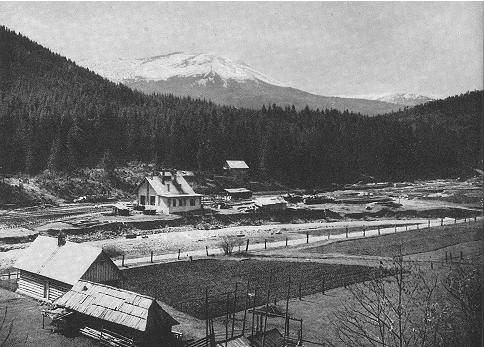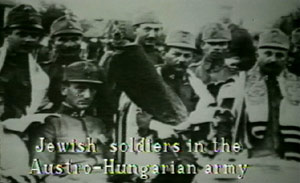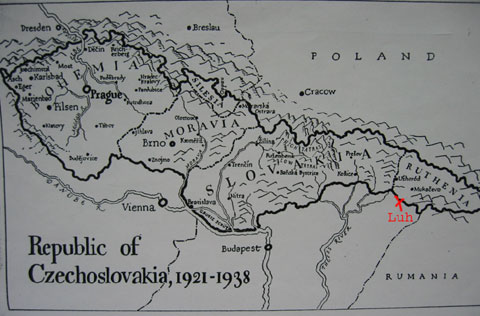|
To go back to Page One of Memorial Click This Link
Here
Carpathia And The Jews For close to a 1,000 years the region known as Sub-Carpathian Ruthenia had belonged to the Hungarian Empire.After World War One which saw the collapse of the Astro-Hunagrian Empire Czechoslovakia was formed and Ruthenia became part of this new liberal republic. Jews had settled in the Hungarian Empire as far back as the 11TH Century as the taxes records has shown this to be true.In the late 17TH Century the Austrian Hapsburgs defeated the Turkish Ottoman Empire and around this time one sees a greater amount of emigration to the Astro-Hungarian Empire.Many Jews are among those who come to Hungary looking for a better life and an escape from persecution.By the end of the 18TH Century there were approximately 80,000 Jews residing within the borders of the Astro-Hungarian Empire.A large portion of these Jews had come from Galicia where the murderous Pograms had claimed 1,000's of lives. The region of Carpathia was mostly populated by peasants living in small mountain villages.The Jews who emigrated here were quick to become traders and this was probably due to the fact that they had many contacts outside of this rural area.Jews also became loggers,carpenters,farmers,and many other trades as Jews were industrious and would work hard. The region was officially called Subcarpathia (Kárpátalja) or North-Eastern Upper Hungary as part of Hungary; Subcarpathian Rus/Ruthenia/Russia or Subcarpathian Ukraine (Czech/Slovak Podkarpatská Rus, Ukrainian Підкарпатська Русь) or since 1927 also Subcarpathian Land (Země/Zem podkarpatskoruská, Země/Zem podkarpatskoruská) after Trianon until 1938 as part of Czechoslovakia; Carpatho-Ukraine from November 1938 to March 1939, autonomous within Czechoslovakia; Subcarpathia again when it was reannexed by Hungary 1939-1945; and since then, as part of the Ukrainian SSR and later by an independent Ukraine it is called Transcarpathia. Alternative unofficial names used in Czechoslovakia before WWII were: Subcarpathia (Podkarpatsko), Carpathian Rus/Ruthenia/Russia (Karpatská Rus), Hungarian Rus/Ruthenia/Russia (Uherská/Uhorská Rus, rare). In a Ukrainian context, has been known as Transcarpathia or Transcarpathian Ukraine (Закарпаття, Закарпатська Україна, Zakarpattia, Zakarpats'ka Ukraina; Slovak: Zakarpatsko, Zakarpatská Ukrajina).
Ruthenians of Carpathian RutheniaThe area of present-day Carpathian Ruthenia was probably settled by Slavic tribes in the 6th century. The Ruthene population was ethnically the same as the population of the areas north of the Carpathian Mountains. However, because of geographical and political isolation from the main Ukrainian-speaking territory, the inhabitants developed some distinctive features. In addition, between the 12th and 15th centuries, the area had been colonized by groups of Vlach highlanders. They were assimilated into the local Slavic population, but strongly influenced the culture, making it more distinctive from the culture of other Ruthenian-speaking areas. In 19th and 20th centuries, Carpathian Ruthenia was a field of struggle between Ukrainian nationalist and pro-Russian activists. The former claimed the Carpatho-Ruthenians were part of the Ukrainian nation, while the latter claimed them to be a separate ethnicity and nationality, or part of the Russian ethnos. The present-day inhabitants usually consider themselves Ukrainians or Rusyns. HungariansCarpathian Ruthenia was a part of Hungary for almost 1000 years. At the beginning of the 20th century, the nobility and middle class was almost solely Hungarian-speaking. Following separation of Carpathian Ruthenia from Hungary, the Hungarian population decreased slightly; the Hungarian census of 1910 shows 185,433, the Czechoslovak census of 1921 shows 111,052, but much of this difference presumably reflects differences in methodology and definitions rather than such a large decline in the region's ethnic Hungarian (Magyar) or Hungarian-speaking population. Even according to the 1921 census, Hungarians still constituted about 18% of the region's total population. On the eve of World War II, the First Vienna Award allowed Hungary to re-annex Carpathian Ruthenia. However, the end of the war was a cataclysm for the ethnic Hungarian population of the area: 10,000 fled before the arrival of Soviet forces. Many of the remaining adult men (25,000) were deported to the Soviet Union; about 30% of them died in Soviet gulags. As a result of war losses, emigration and extermination of Hungarian-speaking Jews, the Hungarian-speaking population of Carpathian Ruthenia decreased to from 161,000 in 1941 (Hungarian census) to 66,000 in 1947 (Soviet census); the low 1947 number is doubtless in part a result of Hungarians' fear to declare their true nationality. As of 2004, about 170,000 (12-13%) inhabitants of Transcarpathia declare Hungarian as their mother tongue. Jewish settlement in Subcarpathian Rus' dates back to the fifteenth century, although it was during the eighteenth century that large numbers of Jews crossed the Carpathian mountains and settled in the northeastern part of the Kingdom of Hungary, including Subcarpathian Rus'. Most of them originated from Galicia, where over-population, political unrest, and military conflicts made living conditions difficult. Civil war and revolts also caused material and human losses in Subcarpathian Rus' until 1711, after which the region was able to absorb larger numbers of newcomers. According to the 1787 census 6,311 Jews inhabited the Hungarian counties of Ung, Bereg, Ugocsa, and Maramaros. In the first half of the nineteenth century immigration from Galicia took place on a massive scale. This was the result of the loss of traditional Jewish autonomy and extreme poverty. Continuing immigration and high birthrates led to an enormous population growth: in 1910 the Jewish communities of the above- mentioned four Hungarian counties contained 128,791 people. The Jewish immigrants soon got used to their new surroundings-not in the least because the region was also populated by Rusyns, whose way of living was familiar to the Jews, since Rusyns also inhabited the southern parts of Galicia. Following the Austrian-Hungarian Ausgleich of 1867, Jews were afforded equal legal status to their Christian neighbors. Although this formal emancipation in the Habsburg monarchy eased the life of the Jews, they were denied the corporate status as a nationality. Instead, they were regarded as Hungarians of the Israelite faith. The new influx of Galician Jews into Subcarpathian Rus' caused a number of conflicts within Hungary's Jewry. While emancipation in 1867 created new possibilities for economic advancement, it also contributed to a greater differentiation within the community. A sharp rift developed between rich and poor Jews, in particular in Subcarpathian Rus'. As among Rusyns, a portion of the new Jewish economic and intellectual elite in towns like Mukacevo, Uzhhorod, and Berehovo acculturated or assimilated with the dominant Hungarian nationality . These ' 'elitist' ' Jews spoke Hungarian, took part in Hungarian culture, and many eventually moved to Hungary's capital of Budapest. The pro- Hungarian Jews felt superior to the great masses of Subcarpathian Jews, who had no part in the process of economic and social advancement and stuck to their own Yiddish culture and language. At best these Jews survived on a subsistence level as workers in forestry and agriculture or as artisans and small shopkeepers. In many ways their economic status was like that of the masses of Rusyns. It was this form of Rusyn-Jewish solidarity that led several authors to conclude that anti-Semitism never became deep-rooted in Subcarpathian Rus' as it had in neighboring regions. While the Jewish and Rusyn communities had their own distinct cultures, at the same time there was extensive interaction and mutual influences. The economic contrasts within the Jewish community of northeastern Hungary were sharpened by religious ones. The poor Subcarpathian Jewish masses were for the most part Orthodox or Hasidic, whereas the entrepreneurial and commercial elite came to be more reform-oriented and liberal. But even among the masses there were divisions. Serious conflict existed between the Orthodox rabbi-dominated Mitnaggedim and the Hasidim, while at the same time Hasidic rabbis and their followers fought each other for control and influence. They only united to withstand the enlightened ideas coming from the assimilated and acculturated Jewish middle and upper class.
The earliest census for this region shows that in the County of Bereg in 1700 there were 5 Jewish households,in the county of MarMaros in 1750 there were 50 Jewish households,and in the county of Ung in the mid-17TH Century there is mention of a Jewish Burial Society called "The Chevra Kadisha". Over the years the significance of Carpathia would grow as this was a region where more Conservative Eastern European ideas met the more modern Western ways of thought.Hasidism took a firm root here as well as the more traditional Orthodox way of thinking.The more modern ways preched assimilation into local culture while the old Orthodox ways did not. The famous Menachem Mendel (1768-1825) moved among the many villages of Carpathia preching the Hasidic philosophies of joyous living and love for Israel.Eventually he moved his court to Vishnitz,Buchovina and the Vishnitzer Hasidics still practice with members worldwide.There were many other famous Hasidic Rabbis who preached in Carpathia and many modern Hasidic Sects can trace their beginnings back to this important rural region. In the mid-19TH Century race riots and protests sprung up all over Europe and for the Jews the results were better laws and more freedoms to the king's subjects.At this time you see a lot of the wooden synagogues being built throughout the Carpathian Region.More and more Jews get involved in business and Zionism beings to spread which leads to many spirited debates as to who has the right ideas.Reformist Jewish movements gain speed but still it is the Orthodox and Hasidic Philosophies that are most observed. The outbreak of World War One caused a great deal of Jews to cross into Carpathia and beyond into Hungary.When Russian troops reched the Notheast Counties of the Astro-Hungarian Empire many Jewish families fled south and west towards Hungary.The southern part of Marmaros County where the village of Luh was became swollen with refugees.The local Jewish community did it's best to cope with this and feed and give shelter to these Refugees.My grandfather and many of the other Jewish males joined the Astro-Hungarian Army to serve in World War One.At this time Jews were allowed to fight for their country and most were proud to do this.They fought bravely and also practised the religion on the battlefields.There are pictures of Jewish soldiers in Army clothes as well as religious garb.Some won honorable medals and some never came back like any other war.My grandfather was captured by the Russians and served some time in a Russian POW Camp.In 1918 the war ended and the Astro-Hungarian Empire collapsed.This would bring about many changes. I also have some new information on my grandfather and on other men who would of served in the Austro-Hungarian Army.First is the map I put up which is shows next to Marmaros the number 85.What this means is all eligible men from Marmaros County would of served in K.U.K. IR85.This means Infantry Regiment #85.My grandfather may have lived in Budapest so he would of entered a Budapest Infantry Regiment.I am now going to copy the info I have so far on WW1 Marmaros Men. I am still busy tracing the routes of these regiments.I have maps of the
Austro-Hungry,WW1, and modern maps.I have traced the routes from Aug.1914 to
Fall 1915 so far.
Here is a map of the Czech Republic and you can now see the aproximate area of where the Village of Luh was located.For the next few pages we will zoom in closer to the region with accurate maps. Also we will see some pictures of the countryside and the people who lived there.
|


